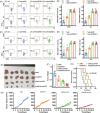iMLGAM: Integrated Machine Learning and Genetic Algorithm-driven Multiomics analysis for pan-cancer immunotherapy response prediction
- PMID: 40236779
- PMCID: PMC11995183
- DOI: 10.1002/imt2.70011
iMLGAM: Integrated Machine Learning and Genetic Algorithm-driven Multiomics analysis for pan-cancer immunotherapy response prediction
Abstract
To address the substantial variability in immune checkpoint blockade (ICB) therapy effectiveness, we developed an innovative R package called integrated Machine Learning and Genetic Algorithm-driven Multiomics analysis (iMLGAM), which establishes a comprehensive scoring system for predicting treatment outcomes through advanced multi-omics data integration. Our research demonstrates that iMLGAM scores exhibit superior predictive performance across independent cohorts, with lower scores correlating significantly with enhanced therapeutic responses and outperforming existing clinical biomarkers. Detailed analysis revealed that tumors with low iMLGAM scores display distinctive immune microenvironment characteristics, including increased immune cell infiltration and amplified antitumor immune responses. Critically, through clustered regularly interspaced short palindromic repeats screening, we identified Centrosomal Protein 55 (CEP55) as a key molecule modulating tumor immune evasion, mechanistically confirming its role in regulating T cell-mediated antitumor immune responses. These findings not only validate iMLGAM as a powerful prognostic tool but also propose CEP55 as a promising therapeutic target, offering novel strategies to enhance ICB treatment efficacy. The iMLGAM package is freely available on GitHub (https://github.com/Yelab1994/iMLGAM), providing researchers with an innovative approach to personalized cancer immunotherapy prediction.
Keywords: genetic algorithms; gene‐pair; immune checkpoint blockade; immunotherapy; pan‐cancer.
© 2025 The Author(s). iMeta published by John Wiley & Sons Australia, Ltd on behalf of iMeta Science.
Conflict of interest statement
The authors declare no conflicts of interest.
Figures





References
-
- Larkin, James , Chiarion‐Sileni Vanna, Gonzalez Rene, Grob Jean Jacques, Cowey C. Lance, Lao Christopher D., Schadendorf Dirk, et al. 2015. “Combined Nivolumab and Ipilimumab or Monotherapy in Untreated Melanoma.” New England Journal of Medicine 373: 23–34. 10.1056/NEJMoa1504030 - DOI - PMC - PubMed
-
- Tawbi, Hussein A. , Hodi F. Stephen, Lipson Evan J., Schadendorf Dirk, Ascierto Paolo A., Matamala Luis, and Gutiérrez Erika Castillo, et al. 2024. “Three‐Year Overall Survival With Nivolumab Plus Relatlimab in Advanced Melanoma From RELATIVITY‐047.” Journal of Clinical Oncology: JCO.24.01124. 10.1200/jco.24.01124 - DOI - PubMed
-
- Ai, Xinghao , Jia Bo, He Zhiyi, Zhang Junping, Zhuo Minglei, Zhao Jun, Wang Zhe, et al. 2024. “Noninvasive Early Identification of Durable Clinical Benefit From Immune Checkpoint Inhibition: A Prospective Multicenter Study (NCT04566432).” Signal Transduction and Targeted Therapy 9: 350. 10.1038/s41392-024-02060-3 - DOI - PMC - PubMed
LinkOut - more resources
Full Text Sources
